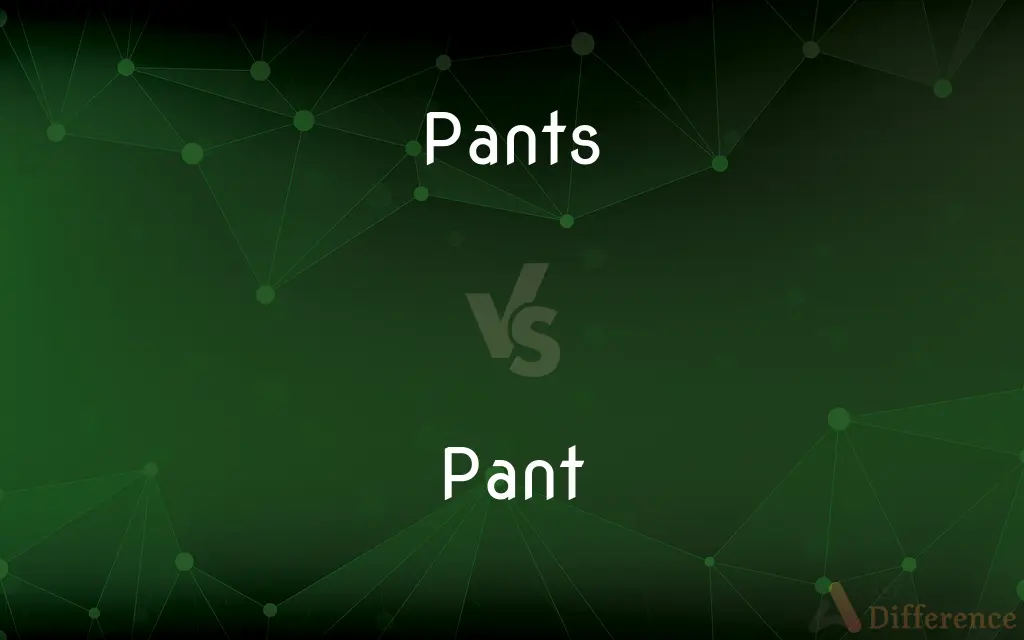Pants vs. Pant — What's the Difference?
By Tayyaba Rehman & Urooj Arif — Updated on March 6, 2024
"Pants" refers to a garment covering the body from the waist to the ankles, with separate sections for each leg, while "pant" typically describes a singular act of breathing heavily or short, quick breaths.

Difference Between Pants and Pant
Table of Contents
ADVERTISEMENT
Key Differences
Pants are a type of clothing worn on the lower part of the body, encompassing both legs separately and extending from the waist to the ankles or knees. They are known for their versatility and are worn by people of all ages and genders for various occasions, ranging from casual to formal. On the other hand, the word "pant" primarily refers to the act of breathing rapidly and shallowly, usually as a result of exertion or the need to catch one's breath. This term can also be used metaphorically to describe a strong desire for something.
While "pants" can be made from a wide array of materials including denim, cotton, wool, and synthetic fabrics to suit different weather conditions and social settings, "pant" as a verb is unrelated to physical materiality and instead conveys a physical or emotional state. The diversity in the types of pants, such as jeans, trousers, sweatpants, and leggings, highlights their functional and stylistic range, whereas the use of "pant" is generally consistent in context, focusing on the physiological response to physical activity or excitement.
In English-speaking regions, "pants" can also have different meanings; in American English, it specifically refers to the garment covering the lower body, while in British English, it can denote underwear. However, "pant" remains universally understood as a verb related to breathing.
The societal and cultural significance of pants has evolved, with changes in fashion and social norms influencing their design and acceptance. Conversely, "pant" captures a timeless, universal human experience not influenced by changing cultural trends.
"Pants" and "pant" serve distinct purposes: one as a staple in global attire, adaptable to trends and functional needs, and the other as a verb depicting a basic human action or desire, illustrating the versatility of English in describing both tangible items and actions.
ADVERTISEMENT
Comparison Chart
Definition
Garment for the lower body with separate parts for each leg.
Verb meaning to breathe heavily or to long for something.
Category
Clothing
Action or desire
Materials
Made from denim, cotton, wool, synthetics, etc.
Not applicable
Varieties
Jeans, trousers, sweatpants, leggings, etc.
Not applicable
Primary Use
To cover and protect the lower body, fashion.
Describes breathing or expressing a strong desire.
Cultural Significance
Evolves with fashion trends, social norms.
Universal across cultures as it relates to a physical response.
English Usage
Different meanings in American and British English.
Consistent meaning in all forms of English.
Influence
Influenced by changes in fashion and social norms.
Not influenced by external factors, related to physical or emotional states.
Compare with Definitions
Pants
Worn for various occasions, from casual to formal.
He prefers wearing comfortable pants for long flights.
Pant
To breathe rapidly and shallowly.
After the run, she started to pant from the effort.
Pants
Reflect changes in fashion and societal norms.
Bell-bottom pants were a hit in the 70s.
Pant
Used metaphorically in literature and poetry.
The parched earth panted for rain.
Pants
A garment covering the lower body from waist to ankles, with separate parts for each leg.
She bought a new pair of pants for the interview.
Pant
Often a response to physical exertion.
The dog began to pant in the summer heat.
Pants
Can be made from a variety of materials.
These wool pants are perfect for winter.
Pant
Can express a strong desire or longing.
He panted for a chance to prove himself.
Pants
Styles include jeans, trousers, sweatpants, and leggings.
Yoga pants have become popular for both exercise and casual wear.
Pant
Universal across cultures as related to physical states.
Regardless of where you're from, you pant after intense activity.
Pants
Underpants or knickers.
Pant
To breathe rapidly in short gasps, as after exertion.
Pants
Trousers
Corduroy pants
Wide pant legs
Pant
To beat loudly or heavily; throb or pulsate.
Pants
Rubbish; nonsense
He thought we were going to be absolute pants
Pant
To give off loud puffs, especially while moving.
Pants
To breathe rapidly in short gasps, as after exertion.
Pant
To long demonstratively; yearn
Was panting for a chance to play.
Pants
To beat loudly or heavily; throb or pulsate.
Pant
To utter hurriedly or breathlessly
I panted my congratulations to the winner of the race.
Pants
To give off loud puffs, especially while moving.
Pant
A short labored breath; a gasp.
Pants
To long demonstratively; yearn
Was panting for a chance to play.
Pant
A throb; a pulsation.
Pants
To utter hurriedly or breathlessly
I panted my congratulations to the winner of the race.
Pant
A short loud puff, as of steam from an engine.
Pants
A short labored breath; a gasp.
Pant
An outer garment that covers the body below the waist, usually to the ankles, and is divided into sections to fit each leg separately
She decided to wear pants instead of a skirt. He bought a new pair of pants.
Pants
A throb; a pulsation.
Pant
Underpants.
Pants
A short loud puff, as of steam from an engine.
Pant
A quick breathing; a catching of the breath; a gasp: the panting of animals such as a dog with their tong hung out- as a form of thermoregulation.
Pants
An outer garment that covers the body below the waist, usually to the ankles, and is divided into sections to fit each leg separately
She decided to wear pants instead of a skirt. He bought a new pair of pants.
Pant
(figurative) Eager longing.
Pants
Underpants.
Pant
(obsolete) A violent palpitation of the heart.
Pants
An outer garment that covers the body from the waist downwards, covering each leg separately, usually as far as the ankles; trousers.
Pant
(fashion) A pair of pants trousers or underpants.
Pants
An undergarment that covers the genitals and often the buttocks and the neighbouring parts of the body; underpants.
Pant
(used attributively as a modifier) Of or relating to pants.
Pant leg
Pants
Rubbish; something worthless.
You're talking pants!
The film was a load [or pile] of pants.
Pant
Any public drinking fountain.
Pants
Of inferior quality, rubbish.
Your mobile is pants — why don’t you get one like mine?
Pant
(intransitive) To long eagerly; to desire earnestly.
Pants
A garment extending from the waist to the knee or ankle, covering each leg separately.
Pant
To long for (something); to be eager for (something).
Pants
Underpants.
Pant
(intransitive) Of the heart, to beat with unnatural violence or rapidity; to palpitate.
Pants
Underpants worn by women; panties.
Pant
(intransitive) To sigh; to flutter; to languish.
Pants
(usually in the plural) a garment extending from the waist to the knee or ankle, covering each leg separately;
He had a sharp crease in his trousers
Pant
(intransitive) To bulge and shrink successively, of iron hulls, etc.
Pants
(usually in the plural) underpants worn by women;
She was afraid that her bloomers might have been showing
Pant
To long eagerly; to desire earnestly; - often used with for or after.
As the hart panteth after the water brooks.
Who pants for glory finds but short repose.
Pant
To beat with unnatural violence or rapidity; to palpitate, or throb; - said of the heart.
Pant
To sigh; to flutter; to languish.
The whispering breezePants on the leaves, and dies upon the trees.
Pant
To breathe forth quickly or in a labored manner; to gasp out.
There is a cavern where my spiritWas panted forth in anguish.
Pant
To long for; to be eager after.
Then shall our hearts pant thee.
Pant
A quick breathing; a catching of the breath; a gasp.
Pant
A violent palpitation of the heart.
Pant
A single leg of a pair of pants. See pants.
Pant
Of or pertaining to pants.
Pant
The noise made by a short puff of steam (as from an engine)
Pant
A short labored intake of breath with the mouth open;
She gave a gasp and fainted
Pant
Breathe noisily, as when one is exhausted;
The runners reached the finish line, panting heavily
Pant
Utter while panting, as if out of breath
Common Curiosities
Can the term "pants" refer to different garments in different countries?
Yes, in American English, "pants" refers to the outer garment worn on the lower body, while in British English, it can also mean underwear.
Are pants and pant interchangeable terms?
No, they refer to different things: "pants" is a garment, while "pant" is an action related to breathing.
Why do people pant?
People pant as a natural response to physical exertion or to regulate body temperature through increased air intake.
How have pants evolved over time?
Pants have evolved in style, material, and societal acceptance, reflecting changes in fashion, professional norms, and cultural trends.
Can "pant" be used in a non-literal sense?
Yes, "pant" can be used metaphorically to express a strong desire or longing for something.
What are pants?
Pants are a garment covering the lower part of the body from the waist down, with separate sections for each leg.
What are some common materials used to make pants?
Pants can be made from denim, cotton, wool, synthetic materials, and more, depending on their intended use and style.
Is panting only a human behavior?
No, many animals pant as a way to cool down or after exertion, similar to humans.
What's the difference between jeans and pants?
Jeans are a type of pants made specifically from denim fabric, known for their durability and casual style.
What does it mean to pant?
To pant means to breathe rapidly and shallowly, typically due to exertion or the need to cool down.
Is it common for pants to have pockets?
Yes, many pants come with pockets, which can be functional or decorative, adding to the garment's practicality and style.
How do I choose the right pants for an occasion?
Choose pants based on the occasion's formality, the outfit's overall style, and what is comfortable and flattering for your body type.
How should pants fit?
The fit of pants can vary based on personal preference and style, ranging from tight to loose, but they should be comfortable and allow for movement.
Can panting be a sign of a health issue?
Excessive panting can be a sign of health issues in both humans and animals, especially if it occurs without apparent cause.
Why are pants considered formal wear?
Pants are considered formal wear when made from high-quality materials and tailored to fit well, often worn with a matching jacket or suit.
Share Your Discovery

Previous Comparison
Spectrophotometer vs. Photometer
Next Comparison
Stipend vs. ScholarshipAuthor Spotlight
Written by
Tayyaba RehmanTayyaba Rehman is a distinguished writer, currently serving as a primary contributor to askdifference.com. As a researcher in semantics and etymology, Tayyaba's passion for the complexity of languages and their distinctions has found a perfect home on the platform. Tayyaba delves into the intricacies of language, distinguishing between commonly confused words and phrases, thereby providing clarity for readers worldwide.
Co-written by
Urooj ArifUrooj is a skilled content writer at Ask Difference, known for her exceptional ability to simplify complex topics into engaging and informative content. With a passion for research and a flair for clear, concise writing, she consistently delivers articles that resonate with our diverse audience.














































